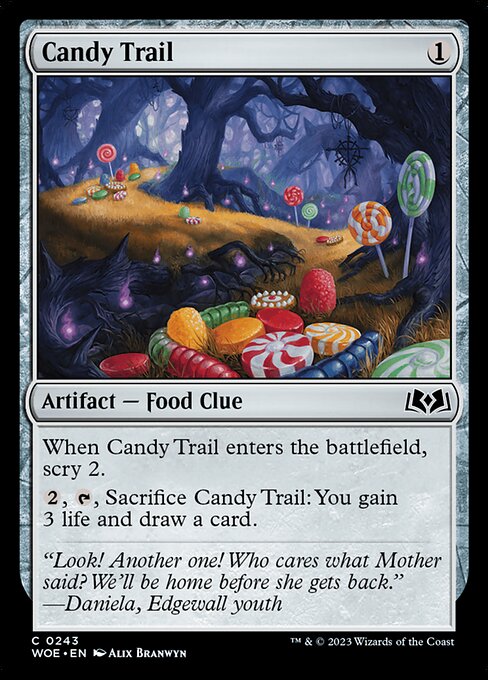
Image courtesy of Scryfall.com
Candy Trail and the Next Era of Creative MTG Design
In the current pulse of Magic: The Gathering’s evolving design language, a small, unassuming artifact from Wilds of Eldraine stands as a surprisingly bold pointer toward the future. Candy Trail—an Artifact with the subtypes Food and Clue—operates on a deceptively simple blueprint: it enters the battlefield with scry 2, and for a modest cost you can sac it to gain life and draw a card. At first glance, it’s a common, colorless piece with a tidy mana cost of {1}. But look closer, and you’ll see a microcosm of how Wizards could push design toward more flavorful, more tactical, and more re-playable artifacts across formats. 🧙♂️🔥💎
This card lives at the intersection of flavor and function. The Food Clue pairing is not just a cute label; it’s a framework that encourages players to think in terms of resource loops and tempo play. Scry 2 on entry delivers immediate card selection, smoothing out early land drops and rough draws—an invitation to weave deck strategy with a pinch of fairy-tale mischief. Then, the activation cost—{2}, tap, sac this artifact—to gain 3 life and draw a card creates a small, reliable payoff that scales with board state and life totals. It’s not flashy, but it compounds; it rewards careful timing, board awareness, and a willingness to lean into a deck’s longer game. The flavor text—“Look! Another one! Who cares what Mother said? We’ll be home before she gets back.”—gives a wink to Eldraine’s whimsical, rule-bending mischief while underscoring how clever resource loops can feel both hopeful and mischievous. Daniel a, Edgewall youth, would be proud of this little snackable engine. 🎨🎲
“Look! Another one! Who cares what Mother said? We’ll be home before she gets back.” — Daniela, Edgewall youth
What Candy Trail Signals About the Future
- Colorless design with big payoffs: Candy Trail shows how a colorless artifact can anchor a lot of in-bag value without leaning on colored mana. Designing more cards that care about entering-the-battlefield triggers, scry-like filtering, and sac-based draws can translate into powerful, universally usable tools that feel distinct from multicolor staples. 🧙♂️
- Token ecosystems as design primitives: The Food and Clue subtypes are a doorway to modular, reusable themes. Future sets can expand on these families with new subtypes, tokens, and payoffs that reinforce specific archetypes—food-based lifegain loops, clue-driven card advantage, and even cross-format synergies that translate well from Commander to Limited. 🔥
- Tempo meets resilience: The small scry effect helps you shape draws, while the sac ability provides a measured buffer against pressure. This balance between filtering and payoff is a model for designing cards that reward thoughtful sequencing rather than raw power. It’s the kind of design that makes playing feel like solving a puzzle rather than just counting faces. ⚔️
- Flavor as function: Eldraine’s fairy-tale aesthetic thrives when mechanics echo the story. Candy Trail’s enter-the-battlefield scry and sac-then-draw life gain example shows that flavor-forward design can be embedded in mechanics without sacrificing performance. Expect more cards that let you “taste” the story as you play. 🎨
Practical Directions for Designers and Players
If you’re a designer, Candy Trail is a case study in economical power with a clear emotional pull. Consider these directions as you prototype the next wave of creative MTG tools:
- Expand the token ecosystem thoughtfully: New Food and Clue-like tokens should offer meaningful, repeatable lines of play. Tokens that interact with life totals, card draw, or on-board filtering create durable avenues for deckbuilding creativity.
- Value engines with predictable friction: Cards that reward you for “buying” time (scry, filter, draw) and then reward you for exploiting that time with a sac effect can sustain engaging gameplay across formats. The friction should be appropriate to the card’s rarity and mana cost, ensuring early-game relevance without overwhelming the metagame.
- Cross-set thematic cohesion: Let mechanics echo Eldraine’s tale-telling vibe across cycles. When a card feels like it belongs to a living world, players remember the moment it changed their game—long after the draft has ended. 🧙♂️
- Accessible complexity: Candy Trail’s 1-mana cost is approachable, while its secondary ability invites deeper planning. Future designs should aim for that sweet spot where new players can ramp into familiar lines, and veterans discover richer combos with repeated play.
For players, these patterns translate into decisions that feel strategic but not opaque. In Limited, Candy Trail helps you trim awkward draws and sculpt the top of your deck with intent. In Commander, the life-and-draw payoff can fuel a long, satisfying resource loop, especially when combined with other artifacts that reward sacrifices or that push extra card draw under your deck’s unique conditions. The flavor text invites you to embrace risk and curiosity—a hallmark of Eldraine’s charm and a beacon for future creative explorations. 💎
As communities discuss the next era of MTG design, it’s worth noting how cards like Candy Trail can seed new archetypes without upending the game’s balance. The blend of scry, a modest mana investment, and a repeatable, low-cost sacrifice payoff demonstrates a careful approach to evergreen design: give players a reliable tool, but pair it with a meaningful decision point that influences timing, ordering, and resource management. The result is a card that feels “classic” in its utility while still offering a spark of novelty—exactly the kind of innovation fans crave as we wander further into the multiverse. 🧙♂️⚔️
And if you’re building a real-life workspace to plan your next MTG prototype sessions, this product might be a perfect companion for desk setup aesthetics while you draft and design. The playground between tabletop strategy and tactile gear is part of what makes the hobby so engaging—a little ritual to accompany your next big set concept. Check it out and harness a touch of style as you chart the future of card design. 🔥🎲